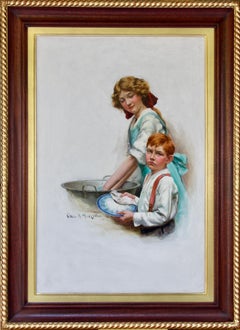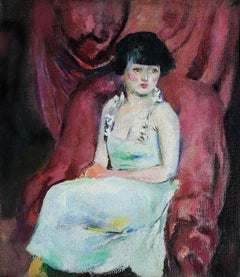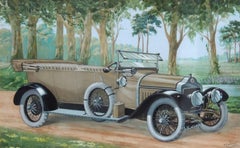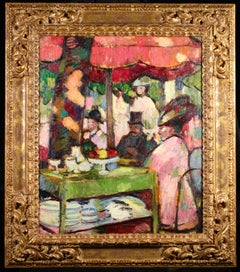" The Littlefield Murals " 3 MURALS OF THE XIT RANCH IN TEXAS. PAINTED Ca. 1910
Major George Washington Littlefield died in 1920. He commissioned E. Martin Hennings around 1910 to do six large paintings of scenes from his 235,000-acre ( part of the XIT ) ranch to hang in his bank in Austin. I have included photos of the paintings hanging in the bank from the Littlefield Book.
I am not sure, but the bank possibly went under sometime in the 197s-1980s. All of the art and antiques were stored, and they had a sale. We have 3 of the six murals that were commissioned by Littlefield.
I have about 40 pages of info on Littlefield and the murals. Too much to enter now but I will be scanning that info later this week.
The Littlefield mansion is still in Downtown Austin. At one time he was the richest man in the state. He was UT's biggest donor for several years prior to his death.
The paintings are
34 x 130
35 x 144
35 x 119
Two are hanging in my friend's ranch house. The other is of a large herd of Hereford Cattle. It is actually pictured
on the cover of the Biography of George Washing Littlefield.
Littlefield, George Washington (1842–1920). George Washington Littlefield, cattleman, banker, and member of the Board of Regents of the University of Texas, son of Fleming and Mildred Terrell (Satterwhite) White Littlefield, was born in Panola County, Mississippi, on June 21, 1842. The family moved to Texas in 1850 after a confrontation between Fleming Littlefield and his wife's family. In marrying Fleming, her overseer, after the death of her first husband, Mildred in her family's eyes had married beneath her station, an action to which her family objected. George grew to young manhood on the family plantation near Belmont, Gonzales County, helping his mother to manage the place after Fleming's death in 1853. George received a basic education in Gonzales College and Baylor University, 1853–55 and 1857. With the outbreak of the Civil War in 1861 George enlisted in Company I, Eighth Texas Cavalry (Terry's Texas Rangers), which fought in the Army of Tennessee. Before his military career was ended at Mossy Creek, Tennessee, on December 26, 1863, by an exploding cannon shell, George rose to the rank of company commander, the youngest in his regiment, and fought at Shiloh, Perryville, and Chickamauga. At Mossy Creek he was promoted to major, a title by which he was addressed after the mid 1880s. Back in Texas after being discharged in 1864, he took control of a plantation belonging to himself and his brother, and "went to work to make the best, as he thought, of a miserable life, having to carry his crutches everywhere." During the war, on January 14, 1863, George married Alice Payne Tillar, with whom he had two children, both of whom died in infancy. In his business ventures thereafter, George Littlefield, who had a highly developed sense of family, utilized nephews and the husbands of nieces as managers.
George's first year's farming after the war ended in disaster caused by three years of worm infestation and flood. Even the road-side store he opened, which prospered because George accepted barter, in particular cattle, could not make up for the losses. In 1871 he gathered a herd of cattle, half of which were his and the rest belonging to his brother, bought more, and drove the herd to Abilene, Kansas, where he sold the animals for enough to discharge all of his debts and leave him with $3,600 "to begin business." Over the next several years entrepreneur Littlefield opened a dry goods store in partnership with J. C. Dilworth in Gonzales, bought and trailed cattle, bought ranches in Caldwell and Hays counties, and developed his plantations. In the trailing business, Littlefield commonly bought his cattle, rather than, as most trailing contractors did, trailing them for a fee. He took the greater risk but reaped the greater reward in their sale. In 1877 Littlefield bought water rights along the Canadian River near Tascosa and established the XIT Ranch which he sold in 1881 for $248,000. Littlefield rejoiced that he had obtained "far more money than he had ever expected to have" and thought of retiring at thirty-nine years of age. But he did not retire, as "he learned. . .that the more money a man makes, the more he has to make, that a man's world opens up a little bit wider with each deal and demands become heavier."
In 1882 Littlefield followed the advice of his principal ranch manager, half-nephew J. Phelps White, and purchased water interests sufficient to control some four million acres of land in New Mexico east of the Pecos River between Fort Sumner and Roswell, on which he established the Bosque Grande Ranch. In 1883 he bought the site of the first windmill on the New Mexico plains at the Four Lakes north of Tatum and developed the Four Lakes Ranch with windmills and barbed wire to control access to water and permit upgrading of stock. His cattle after 1882 carried his LFD brand on their right side. In 1887 Littlefield began acquiring land in Mason County, which soon spread over some 120,000 acres in adjacent Kimble and Menard counties, a ranch he put under management of half-nephew John Will White. In the 1890s Littlefield assembled acreage that came to be known as the LFD Farm in Roswell, New Mexico, on which he established an apple grove, grew forage for cattle, recruited his horses prior to the spring round-up, and maintained the pure-bred bulls that he used to upgrade his herds. Littlefield climaxed his ranching operation in 1901 with the purchase for two dollars per acre of 235,858 acres of the Yellow House (southern) Division of the XIT Ranch in Lamb and Hockley counties. To reach the prevailing wind above the escarpment at the ranch headquarters, Littlefield put up a windmill 130 feet tall to the top of the fan, claimed at the time to be the world's tallest windmill. In 1912 he established the Littlefield Lands Company under
Arthur Pope...




